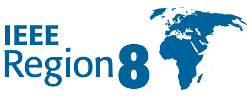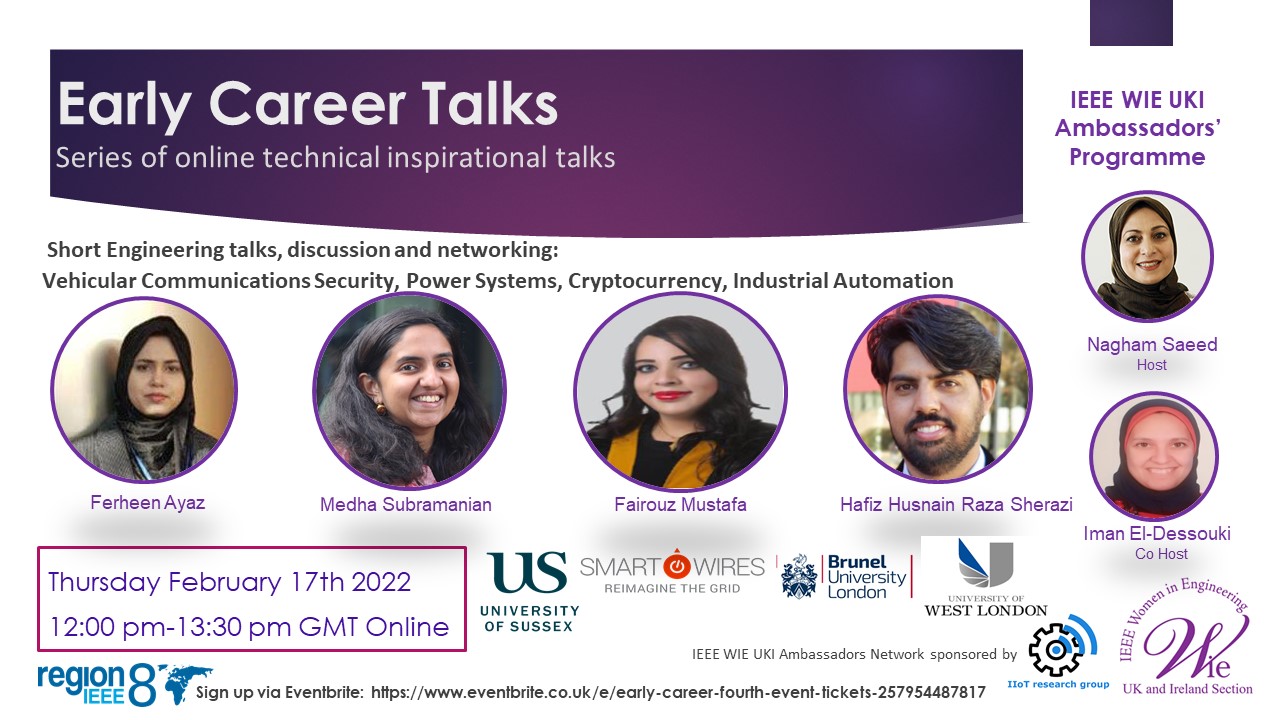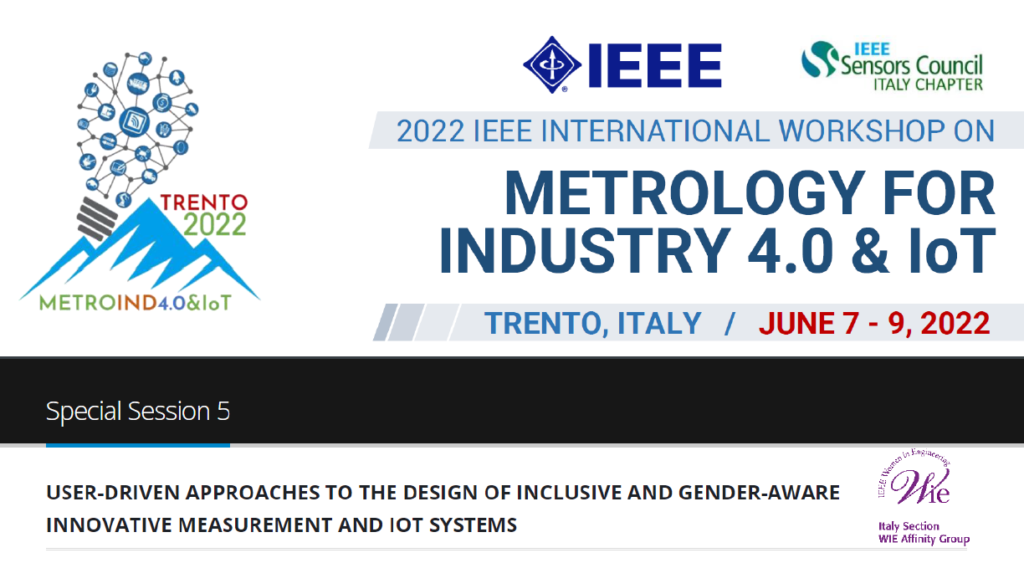Yearly Archives: 2022
Early Career Talks – 4th Event
IEEE WIE UKI goal is to facilitate the recruitment and retention of women in technical disciplines globally. We envision a vibrant community of IEEE women and men collectively using their diverse talents to innovate for the benefit of humanity. IEEE WIE UK and Ireland through the Ambassador Scheme are calling women in engineering to participate in a technical, inspirational, and empowering session tagged “Early Career Talks”. The event has attracting attention from both academia and industry. This forth event converges the novel (state-of-the-Art) research areas in Engineering, establishing networking/collaboration links, exploring new research opportunities for developing interactions between Academia, Industry and Government fostering economic and social development.
Register at: https://www.eventbrite.co.uk/e/early-career-fourth-event-tickets-257954487817
The events is done and you can watch it HERE
Reports – Warsaw
| Director (Antonio Luque) | Director-Elect (Vincenzo Piuri) |
| Past-Director (Magdalena Salazar Palma) | Secretary (Ljupco Karadzinov) |
| Treasurer (Adam Jastrzebski) | V/C Member Activities (Sara Barros) |
| V/C Student Activities (Simay Akar) | V/C Technical Activities (Peter Nagy) |
Subcommittee Reports
| Action for Industry (AfI) | Humanitarian Activities Subcommittee (HuA) | Region 8 News (R8News) |
| Africa Council | Life Member Coordinator (LM) | Region Vitality Coordinator (RVC) |
| Awards & Recognition Subcommittee (A&RSC) | Membership Development Subcommittee (MDSC) | Sections Congress Coordinator |
| Careers New Initiative | New Industry Events Initiative | Social Media Coordinator |
| Chapter Coordination Subcommittee (ChCSC) | New Student Contests Initiative | Standards Coordinator (StC) |
| Conference Coordination SubCommittee (CoCSC) | Nominations and Appointments Subcommittee | Strategic Planning |
| Congress Coordinator (SYP/xSYP) | Professional and Educational Activities Subcommittee (PEAsC) | Voluntary Contribution Fund Coordinator (VCF) |
| Diversity, Equity and Inclusion | Publications and Communications Subcommittee (PnC) | Women in Engineering Coordinator (WIE) |
| Electronic Communications Coordinator (ECC) | Region 8 Sigma | Young Professionals Subcommittee (YP) |
| History Activities Coordinator (HA) | Region 8 Today (Region8Today) |
Section Reports
Report Templates
ISCC 2022 – the 27th IEEE Symposium on Computers and Communications
ISCC 2022, in its 27th edition, will provide an insight into the unique world stemming from the interaction between the fields of computers and communications. ISCC 2022 will provide an international technical forum for experts from industry and academia to exchange ideas and present the results of ongoing research in most state-of-the-art areas of computers and communications. You are invited to submit a full paper, a proposal for a Panel/Invited Session, or a Tutorial, related to the following topics of interest:
-
5th Generation Networks (5G)
Resource Allocation
Network Slicing
Topology Management
5G Core Network and Service Based Architecture
C-RAN and backhaul
SDN and NFV for 5G
Network Stability, Control, and Optimization
Standardization Activities by IEEE, 3GPP, and ETSI -
Security and Privacy
Privacy / Anonymity
Attacks and Defenses
Authentication, Authorization, and Accounting
Hardware Security
Intrusion Detection
Moving Target Defense (MTD)
Blockchain -
Internet of Things (IoT)
LPWAN (LoRa, Sigfox, NB-IoT, LTE-M, Wi-SUN)
6TiSCH, 6LoWPAN, Roll
Rest API, CoAP, CBOR, OSCORE
Operating Systems
Interoperability of IoT protocols and devices
Simulation, emulation, and testbed support
Smart Spaces: design and applications
Cyber-Physical Systems
Telecare Medical Information System
TinyML designed for microcontrollers and IoT-ready devices -
Vehicular Networks
Intelligent Transport Systems (ITS)
IEEE 802.11p ITS-G5
Millimeter Waves
V2X, V2I, V2N, V2V, V2P, V2D, V2G
Inter and Intra vehicle communication and protocols -
Software-Defined
Software-Defined Networks and Network Function Virtualization
Software-Defined Smart Objects
Software-Defined Data Centers
Software-Defined Radio
Overlay and Programmable Networks -
Artificial Intelligence (AI)
Artificial Intelligent Systems applications in Computers and Communications
AI Technologies Game Theory
Machine and Deep Learning of Knowledge
Bio-inspired Computing in Communications
Data Science and Data Engineering
Distributed Knowledge and Processing -
Cloud and Edge Computing
Cloud Computing (IaaS, PaaS, and SaaS)
Mobile Cloud and Mobile Cloud Networking
Fog Computing
Distributed Systems Architecture and Management -
Wireless Networks
Cognitive Radio Networking
Wireless, Cellular, and Mobile Communications
Modeling and Simulation
Signal Processing for Communications -
Services and Protocols
Advances in Internet Protocols
Green Networking
Real-Time Communication Services
Routing and Multicast
Network Design, Optimization, and Management
Network Reliability, Quality of Service, and Quality of Experience
Fault-Tolerance and Error Recovery
Web Services and Service-Oriented Architectures
Standards Evolution
Digital Satellite Communications Service
Localization Protocols
Communications Services and Management
Crowdsourcing applications, Crowdsensing and Mobile CrowdSensing
Social Networks -
Optical Networks
Optical Network Protocols and Architectures
Energy-efficient/green Optical Communications and Networks
Visible Light Communications (Indoor, Outdoor, and Localization)
Optical Wireless Communication Applications for Future Networks -
Application domain / Framework / Architecture
e-Health and Bioinformatics
Smart Grid
Smart City
Industry 4.0
Smart Building -
Software Engineering
Peer-to-Peer Computing
Computing applications
Big Data, Data Mining, and Database Applications
Nominations Open For PRACE Ada Lovelace Award For HPC 2022
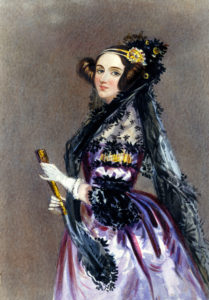 In 2022 PRACE will present for the seventh time its Ada Lovelace Award for HPC. Launched in 2016, the Award is annually presented to a female scientist who makes an outstanding contribution to and impact on HPC in Europe and the world, and serves as a role model for women who are at the start of their scientific careers. The awardee is announced at the annual PRACE Scientific and Industrial Conference (PRACEdays) and is invited to participate in the concluding plenary Panel Discussion.
In 2022 PRACE will present for the seventh time its Ada Lovelace Award for HPC. Launched in 2016, the Award is annually presented to a female scientist who makes an outstanding contribution to and impact on HPC in Europe and the world, and serves as a role model for women who are at the start of their scientific careers. The awardee is announced at the annual PRACE Scientific and Industrial Conference (PRACEdays) and is invited to participate in the concluding plenary Panel Discussion.
From 22 to 24 March 2022, PRACE will organise the eighth edition of its Scientific and Industrial Conference – PRACEdays22 – as part of the EuroHPC Summit Week 2022 in Paris, France.
Read the full announcement HERE
User-driven approaches to the design of inclusive and gender-aware innovative measurement and IoT systems
🟪 The IEEE Italy Section Women in Engineering Italy Section organizes a Special Session at the 2022 IEEE International Workshop on Metrology for Industry 4.0 & IoT, which will be held in Trento, June 7-9, 2022.
🔎 The Special Session “User-driven approaches to the design of inclusive and gender-aware innovative measurement and IoT systems” encourages submissions about how the design of measurement systems and IoT applications may deal with issues user-specific in general, and gender-related in particular, in order to share views, approaches and best practices for the development of user-centered gender-aware innovative devices and systems.
📌 Submission of an extended abstract is open until January 23. Accepted papers will be submitted for inclusion into IEEE Xplore Digital Library.
➡ To know more about the WIE Special Session at MetroInd4.0&IoT 2022, visit https://www.metroind40iot.org/special-session-5
8th International Youth Conference on Energy – Call for Papers
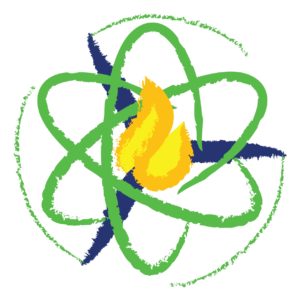 After the pandemic outbreak the International Youth Conference on Energy could not be carried out on its regular schedule, but we were eager to organise the event as soon as possible. Young professionals (undergraduate, MSc, PhD students and entrant engineers) are encouraged to participate and present their work in a friendly international environment, to enjoy the beauty of Eger and to make new connections for the future. Contributions are welcomed from any field related to energy and power engineering. Accepted papers will be submitted for inclusion into IEEE Xplore subject to meeting IEEE Xplore’s scope and quality requirements. IYCE is a Student-led Technical Conference, member of the IEEE IAS YP Student-led Conferences.
After the pandemic outbreak the International Youth Conference on Energy could not be carried out on its regular schedule, but we were eager to organise the event as soon as possible. Young professionals (undergraduate, MSc, PhD students and entrant engineers) are encouraged to participate and present their work in a friendly international environment, to enjoy the beauty of Eger and to make new connections for the future. Contributions are welcomed from any field related to energy and power engineering. Accepted papers will be submitted for inclusion into IEEE Xplore subject to meeting IEEE Xplore’s scope and quality requirements. IYCE is a Student-led Technical Conference, member of the IEEE IAS YP Student-led Conferences.
Important date and topics are available HERE
History Activities – 2022
Team
![]() Martin
Martin
![]() Tony
Tony
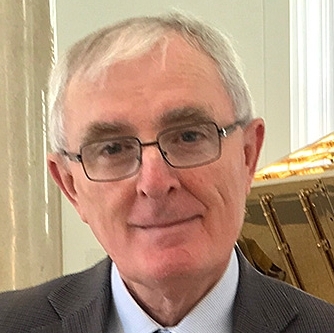 Antonio
Antonio
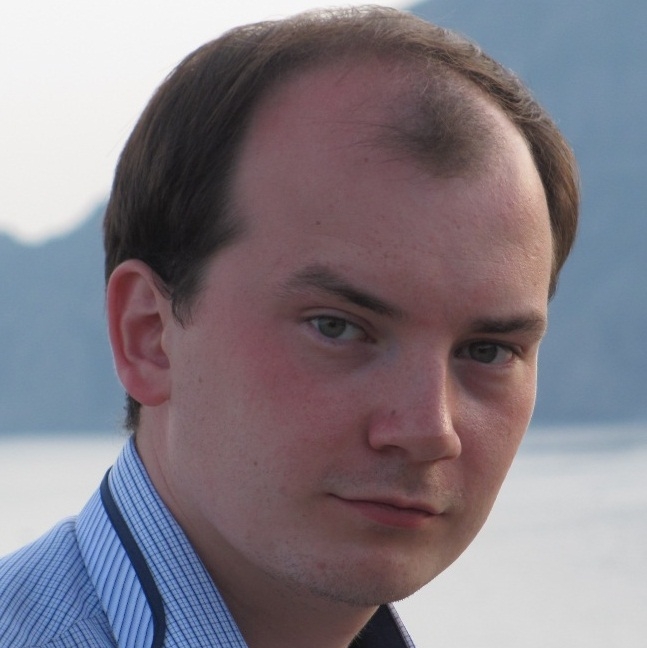 Evgen
Evgen
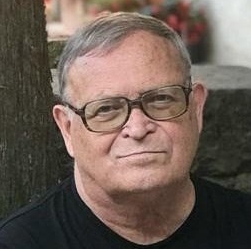 Sergei
Sergei
The History Activities Committee is looking forward to assist you in your history-related activities. The 2022 committee consists of:
- Martin Bastiaans, History Activities Coordinator (2021-2023)
- Tony Davies, Past History Activities Coordinator (2013-2020)
- Antonio Savini, current IEEE History Committee chair (2022-2023)
- Evgen Pichkalyov, current IEEE History Committee member (2022-2023)
- Sergei Prokhorov, current IEEE History Committee member (2022-2023)
Feel free to contact us at [email protected], but include [email protected] in CC, because the email alias may not work properly.
- List of Region 8 Section history officers (.xlsx)
- List of Region 8 History Network subscribers (.xlsx)
- List of Region 8 History Committee relations (.xlsx)
News
- IEEE Region 8 History webpage
The Region 8 History webpage is updated whenever new information becomes available. - The HISTELCON 2023 website is live at https://2023.ieee-histelcon.org.
- Recently approved IEEE Milestones:
Grenoble, France, MPEG Multimedia Integrated Circuits, 1984-1993
Dedication ceremony To be decided – IEEE France Section
Beginning in 1984, Thomson Semiconducteurs (now STMicroelectronics) developed multimedia integrated circuits, which accelerated Moving Picture Experts Group (MPEG) standards. By 1993, MPEG-2 integrated decoders – including innovative discrete cosine transform (developed jointly with ENST, now TelecomParisTech), bitstream decompression, on-the-fly motion compensation, and display unit – were announced in one silicon die: the STi3500. Subsequent MPEG-2 worldwide adoption made compressed full-motion video and audio inexpensive and available for everyday use.
Paris, France, Invention of sonar, 1915-1918
Dedication ceremony To be decided – IEEE France Section
At this location, from 1915 to 1918, Paul Langevin designed a submarine detector using piezoelectric quartz crystal transceivers. Based on Constantin Chilowsky’s proposed use of ultrasounds, this improved method for submarine ultrasonic echo detection (later called sonar) obtained 4000-meter echo soundings from the cable ship Charente in the Bay of Biscay. It was later used successfully during World War II, and echo sounding led to other applications including medical echography.
Paris, France, The birth of electrodynamics, 1820-1827
Dedication ceremony To be decided – IEEE France Section
Stimulated by experimental reports that an electric current could deflect a compass needle, André-Marie Ampère discovered the fundamental law of electrodynamics, the science of interactions between electric currents. He then developed the theory that electric currents are responsible for magnetism. These achievements formed the basis for electrical technologies, including electric motors and generators. In 1881, the International Electrical Congress named the unit of electric current the ‘ampere’ (A). - Recently dedicated IEEE Milestones:
Budapest, Hungary, Budapest metroline No. 1, 1896
Dedication ceremony 20 October 2022 – IEEE Hungary Section
In 1896, Budapest Metro Line No. 1 was inaugurated, the first underground railway designed specifically to use electric power, rather than adapted from steam-powered systems. It offered several innovative elements, including bidirectional motor carriages, the “goose neck chassis,” and electric lighting in the stations and carriages. This line’s design influenced later subway construction in Boston, Paris, Berlin, and other metropolitan areas worldwide.
Hayes, England, First computerized tomography (CT) X-ray scanner, 1971
Dedication ceremony 26 October 2022 – IEEE UK and Ireland Section
On 1 October 1971, a team at the EMI Research Laboratories located on this site produced an image of a patient’s brain, using the world’s first clinical X-ray computerized tomography scanner, based on the patented inventions of Godfrey Hounsfield. The practical realization of high-resolution X-ray images of internal structures of the human body marked the beginning of a new era in clinical medicine. - Recently dedicated IEEE Milestones:
Eynsham, England, Active shielding of superconducting magnets for MRI, 1984-1989
Dedication ceremony 17 June 2022 – IEEE UK and Ireland Section
At this site, the first actively shielded superconducting magnets for diagnostic Magnetic Resonance Imaging (MRI) use were conceived, designed, and produced. Active shielding reduced the size, weight, and installed cost of MRI systems, allowing them to be more easily transported and advantageously located, thereby benefiting advanced medical diagnosis worldwide.
Manchester, England, Manchester University “Baby” computer and its derivatives, 1948-1951
Dedication ceremony 21 June 2022 – IEEE UK and Ireland Section
At this site on 21 June 1948 the “Baby” became the first computer to execute a program stored in addressable read-write electronic memory. “Baby” validated Williams-Kilburn Tube random-access memories, later widely used, and led to the 1949 Manchester Mark I which pioneered index registers. In February 1951, Ferranti Ltd’s commercial derivative became the first electronic computer marketed as a standard product delivered to a customer.
See also the article in IEEE Spectrum.
Manchester, England, The Atlas computer and the invention of virtual memory, 1957-1962
Dedication ceremony 21 June 2022 – IEEE UK and Ireland Section
The Atlas computer was designed and built in this building by Tom Kilburn and a joint team of the University of Manchester and Ferranti Ltd. The most significant new feature of Atlas was the invention of virtual memory, allowing memories of different speeds and capacities to act as a single large fast memory separately available to multiple users. Virtual memory became a standard feature of general-purpose computers.<\li> - Recently approved IEEE Milestone:
Hayes, England, First computerized tomography (CT) X-ray scanner, 1971
Dedication ceremony To be decided – IEEE UK and Ireland Section
On 1 October 1971, a team at the EMI Research Laboratories located on this site produced an image of a patient’s brain, using the world’s first clinical X-ray computerized tomography scanner, based on the patented inventions of Godfrey Hounsfield. The practical realization of high-resolution X-ray images of internal structures of the human body marked the beginning of a new era in clinical medicine. - Recently added Oral History:
The List of Oral Histories related to Region 8 (.xlsx) on the Region 8 History webpage has been updated by adding the transcript of an interview with Jiří Zlatuška; see Jiří Zlatuška, an oral history conducted in 2020 by Helena Durnová, IEEE Computer Society. The interviewee is residing in the IEEE Czechoslovakia Section. - Recently dedicated IEEE Milestone:
Leiden, Netherlands, String galvanometer to record a human electrocardiogram, 1901-1905
Dedication ceremony 8 April 2022 – IEEE Benelux Section
On 22 March 1905, the first successful clinical recording of a human electrocardiogram (ECG) took place at this location, which at the time was the Academic Hospital Leiden. Willem Einthoven’s pioneering work, from 1901 to 1905, resulted in a string galvanometer specifically designed to measure and record the heart’s electrical activity, which made this medical achievement possible. This invention marked the beginning of electrocardiography as a major clinical diagnostic tool. - Proceedings of HISTELCON
The proceedings of HISTELCON 1 through 7, available at IEEE Xplore, are now freely accessible for everyone without any payment; see also the HISTELCON entry on ETHW.- Paris, France, 11–12 September 2008
- Madrid, Spain, 3–5 November 2010
- Pavia, Italy, 5–7 September 2012
- Tel Aviv, Israel, 16–21 August 2015, held jointly with the 42nd annual meeting of ICOHTEC, the International Committee for the History of Technology: History of High-Technologies and Their Socio-Cultural Contexts
- Kobe, Japan, 7–8 August 2017, together with IEEE Region 10
- Glasgow, United Kingdom, 18–19 September 2019
- Moscow, Russia, 10-12 November 2021
- IEEE Milestone dedications planned
- Leiden, Netherlands, String galvanometer to record a human electrocardiogram, 1901–1905; approved 24–11–2019.
Dedication planned for 8 April 2022. - Eynsham, England, Active shielding of superconducting magnets for MRI, 1984–1989; approved 24–11–2019.
Dedication planned for 16–17 June 2022. - Manchester, England, Manchester University “Baby” computer and its derivatives, 1948–1951; approved 27–06–2021.
Dedication planned for 20–21 June 2022. - Manchester, England, The Atlas computer and the invention of virtual memory, 1957–1962; approved 27–06–2021.
Dedication planned for 20–21 June 2022.
- Leiden, Netherlands, String galvanometer to record a human electrocardiogram, 1901–1905; approved 24–11–2019.
- IEEE Milestone proposals under consideration by the IEEE History Committee
- UK & Ireland: First computerized tomography (CT) X-ray scanner, 1967-1975
- Switzerland: Discovery of high temperature superconductivity, 1986
- France: Paul Langevin’s invention of sonar, 1915-1918
- North Macedonia: First control of physical object (robot) using signals from human brain, 1988
- Benelux: ADSL: expediting broadband internet access for society, 1993-1997
- France: Multimedia integrated circuits for MPEG, 1986
- News Archive — News items about Milestones and Conferences are ordered by year: 2022, 2021, 2019, 2017, 2015, 2014, 2013, 2010.
Highlights from 2021 – see also News Archive: 2021
- Minutes of the IEEE Region 8 Committee meetings
With the exception of four Region 8 Committee meetings – in Geneva (7 September 1965), Leuven (16 September 1966), Tel Aviv (24 October 1968), and Dubrovnik (25-26 October 1974) – we have (scanned) versions of all meeting minutes; and of the above-mentioned meetings in Leuven and Tel Aviv, we have the agendas. The (scanned) versions have been collected in five pdf files, which are available for download:
1962-1970 (.pdf), 1971-1983 (.pdf), 1984-1993 (.pdf), 1994-2009 (.pdf), and 2010-2020 (.pdf). - Old issues of IEEE Region 8 News
Digital versions of IEEE Region 8 News from 2002 onward can be found in the Region 8 News archive of back issues. All older issues of IEEE Region 8 News and its predecessors — IEEE Region 8 newsletter (1967-1986; issues 1-76) and IEEE Region EIGHT News (1987-1989; issues 77-85) — have now been scanned: 1092 pages with a total size of about 0.7 GB. Note that volume numbers were introduced in Region 8 News in 1998 with the August issue (Volume 1, Number 1); until then, the numbering was consecutively from 1 till 122.
The scanned versions can be downloaded by clicking on the links in the table that can be found here. In addition to news about the IEEE and the activities that took place on the Region level, these old issues contain lots of information about our Sections and may thus form a valuable source of information, especially for those Sections who want to fill the gaps in their history. To help Sections, an index has been created to direct Section leaders to the relevant pages in the issues 1-122 (December 1967 – May 1998) where news about their Section can be found. - HISTELCON 2021 has been completely virtual as a Zoom meeting without any registration fee.
The detailed schedule with speakers and titles can be found at http://histelcon2021.org/schedule. - IEEE Special Citation in History dedicated in 2021:
Paderborn, Germany, Heinz Nixdorf MuseumsForum (HNF), 1996
Dedication ceremony 23 October 2021 – IEEE Germany Section
One of the largest computer museums in the world, the Heinz Nixdorf MuseumsForum presents 5000 years of computing history from the emergence of numbers and lettering circa 3000 B.C.E. to the modern digital age. Through presentations, workshops, seminars, and exhibitions, it has provided a broad audience with the insights and perspectives required to navigate a world that is increasingly shaped by digital technology. - IEEE Milestones dedicated in 2021:
Roma, Italy, Giovanni Giorgi’s contribution to the rationalized system of units, 1901-1902
Dedication ceremony 15 December 2021 – IEEE Italy Section
Giovanni Giorgi proposed rationalizing the equations of electromagnetism. His proposal added an electrical unit to the three mechanical units of measurement (meter, kilogram, second). While he was a professor at the University of Rome, the International Electrotechnical Commission adopted a version of Giorgi’s system. His ideas formed the basis of the universally adopted International System (SI) of units, currently used in all fields of science and engineering.
Agrate Brianza, Milano, Italy, Multiple silicon technologies on a chip, 1985
Dedication ceremony 18 May 2021 – IEEE Italy Section
SGS (now STMicroelectronics) pioneered the super-integrated silicon-gate process combining Bipolar, CMOS and DMOS (BCD) transistors in single chips for complex, power-demanding applications. The first integrated circuit, named L6202, was capable of controlling up to 60V–5A at 300 kHz. Subsequent automotive, computer, and industrial applications extensively adopted this process technology, which enabled chip designers flexibly and reliably to combine power, analog and signal processing.
Cascina, Pisa, Italy, Gravitational-wave antenna, 1972-1989
Dedication ceremony 3 February 2021 – IEEE Italy Section
Initially developed from 1972 to 1989, the gravitational-wave antenna enabled detection of ripples in spacetime propagating at the speed of light, as predicted by Albert Einstein’s 1916 Theory of General Relativity. Construction of the Virgo Gravitational-Wave Observatory commenced in 1997. In 2017, Virgo and two antennas located in the US launched the era of Multi-Messenger Astronomy with the coordinated detection of gravitational waves from a binary neutron star merger.
Torino, Italy, Rotating fields and early induction motors, 1885-1888
Dedication ceremony 21 January 2021 – IEEE Italy Section
Galileo Ferraris, professor at the Italian Industrial Museum (now Polytechnic) of Turin, conceived and demonstrated the principle of the rotating magnetic field. Ferraris’ field, produced by two stationary coils with perpendicular axes, was driven by alternating currents phase-shifted by 90 degrees. Ferraris also constructed prototypes of two-phase AC motors. Rotating fields, polyphase currents, and their application to induction motors had a fundamental role in the electrification of the world.
IEEE Milestones
- The IEEE Milestones Program honors significant technical achievements in all areas associated with IEEE. It is a program of the IEEE History Committee, administered through the IEEE History Center.
- List of IEEE Milestones worldwide
- List of IEEE Milestones in Region 8 (.xlsx) with links to ETHW and to their locations on Google maps
- Status report of Milestones under consideration by the IEEE History Committee
- List of achievements suitable for Milestones
- List of achievements suitable for Milestones featuring women
- List of candidate Milestones in Region 8 approaching major anniversaries (.xlsx)
Engineering and Technology History Wiki
- The Engineering and Technology History Wiki is a wiki-based platform that allows IEEE members and Organizational Units to collaboratively preserve and share their history (including, for instance, the history of individual IEEE Sections).
- List of Region 8 Section histories (.xlsx)
- List of Oral Histories worldwide
- List of Oral Histories related to Region 8 (.xlsx)
- List of First-Hand Histories worldwide
Region 8 history book
- The book A short history of IRE Region 9 / IEEE Region 8 (.pdf) presents a history of IEEE Region 8 spanning its origins from the IRE Region in Europe, through the IRE/AIEE merger forming the IEEE and subsequently to the present day Region 8 consisting of Europe, the Middle East, and Africa.
Note that if you click on the link above and open the Document Outline in the left-hand side bar, you can immediately jump to any section of the book and easily navigate through it. - More information about the history of Region 8 can be found on ieeer8.org/history/
Documents archive
- Current report of the History Activities Coordinator (.pdf)
- Region 8 History Activities – Final Report 2021-2022) (.pdf)
- Previous reports of the History Activities Coordinator (Martin Bastiaans, 2021-2022) (.pdf) in reverse order
- Previous reports of the History Activities Coordinator (Tony Davies, 2013-2020) (.pdf) in reverse order
- Previous reports of the History Activities Coordinator (Jacob Baal-Schem, 2007-2010) (.pdf) in reverse order
IEEE History Center – a selection of additional weblinks
- IEEE History Center Programs & Projects
- IEEE History Center Publications
- IEEE History Center Newsletters
- REACH – Raising Engineering Awareness through the Conduit of History
- IEEE Life Members’ Fellowship in the History of Electrical and Computing Technology
- Elizabeth & Emerson Pugh Young Scholar in Residence at the IEEE History Center
- IEEE William and Joyce Middleton Electrical Engineering History Award
- Bernard S. Finn IEEE History Prize
Early-Stage Researchers (ESR) Training | SMARTGYsum
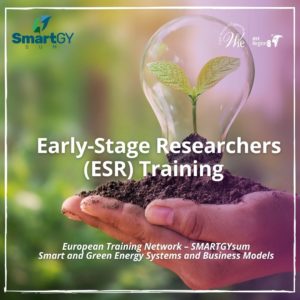 SMARTGYsum (SMART Green energY Systems and bUsiness Models) project groups together leading European Universities and Institutions (the consortium is composed by 13 universities and 14 companies/institutions) with the aim to implement a multidisciplinary and innovative research and training program, bringing to enable a new generation of Early-Stage Researchers (ESR) to foster a New Green Energy Economy in Europe. ESR will acquire the knowledge, methods and skills across a wide range of disciplines around the Energy ecosystem, Renewable Electric Energy Systems and Business Models for the deployment of the Green Energy System. Trained ESR will have the technical and economical knowledge to break the barriers for the deployment of energy transition as market and social barriers (price distortion through externalities, low priority of energy issues, split incentives); financial barriers (investment, high up-front costs, lack of access to capital); information failures (lack of awareness, knowledge and competence); or regulatory barriers (restrictive procurement rules).
SMARTGYsum (SMART Green energY Systems and bUsiness Models) project groups together leading European Universities and Institutions (the consortium is composed by 13 universities and 14 companies/institutions) with the aim to implement a multidisciplinary and innovative research and training program, bringing to enable a new generation of Early-Stage Researchers (ESR) to foster a New Green Energy Economy in Europe. ESR will acquire the knowledge, methods and skills across a wide range of disciplines around the Energy ecosystem, Renewable Electric Energy Systems and Business Models for the deployment of the Green Energy System. Trained ESR will have the technical and economical knowledge to break the barriers for the deployment of energy transition as market and social barriers (price distortion through externalities, low priority of energy issues, split incentives); financial barriers (investment, high up-front costs, lack of access to capital); information failures (lack of awareness, knowledge and competence); or regulatory barriers (restrictive procurement rules).
SMARTGYsum project is aimed to train 15 creative and innovative researchers in the field of green energy system and business models. It will incorporate multidisciplinary knowledge, covering Power Electronics, Electric Engineering, Material Sciences, ICT, Data Sciences, Value Chains, Finance and Investments, Management of Energy Markets, Economical and Policy instruments.
The researchers trained in this network will be able to convert state-of-the art knowledge and ideas into new products for economic and social benefit and promoting the energy transition.
As a trained researcher you will have many opportunities to develop an industrial career in any part of the world, but especially in the EU. You will be trained in electric, power electronic and ITC technologies and in business models, and have a secondment in a complimentary training environment as part of your assignments.
ESRs will take part in the whole researching process, starting with the proposal of new ideas, going from the design to the experimental validation of prototypes in the laboratory and industry facilities, and finishing with the developing of the business models.
Available positions are listed in https://smartgysum.eu/Home/ResearchFramework where there are links to EURAXESS calls and to fill application.
There is also information about the Recruitment process guidelines as Public deliverable D1.2 in https://smartgysum.eu/Home/ProjectWorkPlan.
